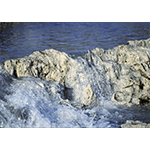Thermal Baths of Saturnia
The thermal baths of Saturnia have very ancient origins, as proven by Etruscan remains found in the area. The baths were appreciated by the Romans too, who made them a resting station along the Via Clodia. In the Middle Ages Saturnia, like many other thermal centres, underwent a stage of decline. In the following centuries, its fortunes alternated. At the end of the 18th century the naturalist Giorgio Santi, describing the territory of the two Sienese provinces (Grosseto and Siena) in his Viaggio secondo per le due provincie Senesi, mentioned the "ruined and deserted Saturnia", whose waters had been utilised, since the most remote times, to treat the diseases of men as well as those of animals: "They come to make use of these Baths by immersion, both Men, and Cattle, they being credited with the cure of skin diseases. The mud filled with Sulphur deposited by the water in the great Basin is gathered, reduced to small round masses, and sold dried to the Shepherds, who then soak it in water and rub it on the scabious Sheep, and due to the effect of the Sulphur, often with good success."
Santi not only described the Baths of Saturnia and the Holy Bath, but also formulated a hypothesis on the origin of the travertine rocks so abundant in that area: "The aspect of the Travertines leads me to believe, correctly I think, that in very ancient times, even before the foundation of Saturnia, there flowed from the high and level top of that hill the water of the present-day Baths which, here accumulating encrustations, and sediments, went to form those masses of Travertine, which, by building up in layers and expanding, finally obstructed the Springs, and blocked the course of their waters; which thus obliged to find a path elsewhere, had to gush out in the adjacent plain, where they are found today, to then again with the passage of time undergo new obstructions, and new changes of site."
In the early 20th century, thanks to better environmental conditions, the malaria that had plagued the Maremma in the past having been overcome, the baths were entirely rebuilt, becoming an important and spectacular site of thermal tourism. Today the waters and mud-packs of Saturnia, famous the world over, are used to treat numerous diseases.
****************************
Texts by Graziano Magrini
English translation by Catherine Frost
Last update 05/feb/2008




